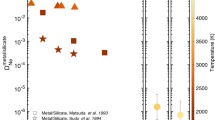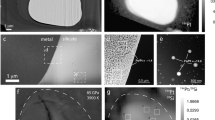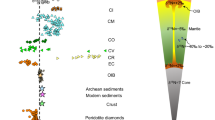Abstract
If the Earth's mantle were in equilibrium with its core, the mantle would contain three orders of magnitude less of the noble metals (platinum-group elements Pt, Os, Ir, Ru, Pd and Rh, plus Au and Re) than are observed. An explanation put forward to account for this disparity has been that the last 1% of the Earth's accretion occurred after the iron-rich core had separated from the mantle1,2. Recent debate has accordingly centred on which meteorite class or classes made up this ‘late veneer’ of accretion3. Here we present analyses of noble-metal concentrations in oceanic peridotites (plutonic rocks which are thought to represent samples of the Earth's upper mantle). We find that the average oceanic-mantle Os/Ir ratio is indistinguishable from that in the CI-type carbonaceous chondrites4, but that Ru/Ir, Pt/Ir, Rh/Ir and Pd/Ir ratios are about 40% higher. A late veneer composed of strictly CI-type carbonaceous chondritic composition is therefore not compatible with these observations. The data also allows us to rule out other carbonaceous chondrites5, enstatite chondrites6,7 and ordinary chondrites8 as significant late veneer components. We propose that mixing of differentiated outer-core material back into the mantle after core separation could account for the observed noble-metal ratios and abundances in the mantle without any late accretionary veneer.
This is a preview of subscription content, access via your institution
Access options
Subscribe to this journal
Receive 51 print issues and online access
$199.00 per year
only $3.90 per issue
Buy this article
- Purchase on Springer Link
- Instant access to full article PDF
Prices may be subject to local taxes which are calculated during checkout



Similar content being viewed by others
References
Chou, C. L. Fractionation of siderophile elements in the Earth's upper mantle. Proc. Lunar Planet. Sci. Conf. 9, 219–230 (1978).
Jagoutz, E. et al. The abundances of major, minor and trace elements in the Earth's mantle as derived from primitive ultramafic nodules. Proc. Lunar Planet. Sci. Conf. 2, 2031–2050 (1979).
Meisel, T., Walker, R. J. & Morgan, J. W. The osmium isotopic composition of the primitive upper mantle. Nature 383, 517–520 (1996).
Palme, H. & Beer, H. in Astronomy and Astrophysics (ed. Voigt, H. H.) 196–221 (Springer, Berlin, (1993)).
Jochum, K. P. Rhodium and other platinum-group elements in carbonaceous chondrites. Geochim. Cosmochim. Acta 60, 3353–3357 (1996).
Hertogen, J., Janssens, M. J., Takahashi, H., Morgan, J. W. & Anders, E. Enstatite chondrites; trace element clues to their origin. Geochim. Cosmochim. Acta 47, 2241–2255 (1983).
Kallemeyn, G. W. & Wasson, J. T. Compositions of enstatite (EH3, EH4,5 and EL6) chondrites; implications regarding their formation. Geochim. Cosmochim. Acta 50, 2153–2164 (1986).
Kong, P. & Ebihara, M. The origin and nebular history of the metal phase of ordinary chondrites. Geochim. Cosmochim. Acta 61, 2317–2329 (1997).
Cannat, M. et al. Site 920. Proc. Ocean Drilling Progr. Part A: Init. Rep. 153, 45–119 (1995).
Gillis, K. M. et al. Site 895. Proc. Ocean Drilling Progr. Part A: Init. Rep. 147, 109–157 (1993).
Snow, J. E. & Dick, H. J. B. Pervasive magnesium loss by marine weathering of peridotite. Geochim. Cosmochim. Acta 59, 4219–4235 (1995).
Snow, J. E. & Reisberg, L. Os isotopic systematics of the MORB mantle; results from altered abyssal peridotites. Earth Planet. Sci. Lett. 133, 411–421 (1995).
Peach, C. L., Mathez, E. A. & Keays, R. R. Sulfide melt–silicate melt distribution coefficients for noble metals and other chalcophile elements as deduced from MORB; implications for partial melting. Geochim. Cosmochim. Acta 54, 3379–3389 (1990).
Peach, C. L. & Mathez, E. A. Constraints on the formation of platinum-group element deposits in igneous rocks. Econ. Geol. Bull. Soc. Econ. Geol. 91, 439–450 (1996).
Reisberg, L. & Lorand, J. P. Longevity of sub-continental mantle lithosphere from osmium isotope systematics in orogenic peridotite massifs. Nature 376, 159–162 (1995).
O'Hanley, D. Serpentinites: Records of Tectonic and Petrological History 1–300 (Oxford Univ. Press, New York, (1996).
Pattou, L., Lorand, J. P. & Gros, M. Non-chondritic platinum-group element ratios in the Earth's mantle. Nature 379, 712–715 (1996).
Schmidt, G., Palme, H., Kratz, K.-L. & Kurat, G. Are highly siderophile elements (PGE, Re and Au) fracitonated in the upper mantle? New results on peridotites from Zabargad. Chem. Geol. (submitted).
Anders, E. & Grevesse, N. Abundances of the elements: Meteoritic and solar. Geochim. Cosmochim. Acta 46, 2363–2280 (1989).
Kallemeyn, G. & Wasson, J. The compositional classification of chondrites-I: The carbonaceous chondrite groups. Geochim. Cosmochim. Acta 45, 1217–1230 (1981).
Wasson, J. T. & Kallemeyn, G. W. Compositions of chondrites. Phil. Trans. R. Soc. Lond. A 323, 535–544 (1988).
Walker, R. J., Morgan, J. W. & Horan, M. F. Osmium-187 enrichment in some plumes; evidence for core–mantle interaction? Science 269, 819–822 (1995).
Widom, E. & Shirey, S. Os isotope systematics in the azores: Implications for mantle plume sources. Earth. Planet. Sci. Lett. 142, 451–465 (1996).
Walker, R. et al. Applications of the 190Pt–186Os isotope system to geochemistry and cosmochemistry. Geochim. Cosmochim. Acta (in the press).
Pernicka, E. & Wasson, J. T. Ru, Re, Os, Pt and Au in iron meteorites. Geochim. Cosmochim. Acta 51, 1717–1726 (1987).
Hoashi, M., Brooks, R. R. & Reeves, R. D. Palladium, platinum and ruthenium in iron meteorites and their taxonomic significance. Chem. Geol. 106, 207–218 (1993).
Ryan, D. E., Holzbecher, J. & Brooks, R. R. Rhodium and osmium in iron meteorites. Chem. Geol. 85, 295–303 (1990).
Schmidt, G. & Palme, H. in EAG Workshop: The Origin and Fractionation of Highly Siderophile Elements in the Earth's Mantle (eds Brügman, G., Lorand, J. P. & Palme, H.) 71–72 (Max-Planck Institut für Chemie, Mainz, Germany, (1997)).
Schmidt, G. Clues to the nature of the impacting bodies from platinum-group elements in borehole samples from the clearwater east crater (Canada) and the Boltysh impact crater (Ukraine). Meteorit. Planet. Sci. 32, 761–767 (1997).
Fryer, B. J. & Greenough, J. D. Evidence for mantle heterogeneity from plantinum-group-element abundances in Indian Ocean basalts. Can. J. Earth Sci. 29, 2329–2340 (1992).
Morgan, J. P. & Morgan, W. J. Rare gas and isotopic evolution of the mantle. Terra Abstr. 9, 47 (1997).
Morgan, W. J. & Morgan, J. P. Two-stage melting of a multi-component mantle: A way to generate both OIB and MORB from ‘whole mantle’ convection. Terra Abstr. 9, 57 (1997).
Wasson, J. Meteorites 1–267 (Freeman, New York, (1985)).
Kallemeyn, G. W., Rubin, A. E., Wang, D. & Wasson, J. T. Ordinary chondrites; bulk compositions, classification, lithophile-element fractionations, and composition-petrographic type relationships. Geochim. Cosmochim. Acta 53, 2747–2767 (1989).
Acknowledgements
We thank G. Brügmann, A. W. Hofmann, K. P. Jochum and R. Walker for many useful discussions. Henry Dick and the Ocean Drilling Program kindly provided samples. L. Feld edited the typescript. J.E.S. acknowledges the support of an Alexander-von-Humboldt Fellowship during the course of this work. G.S. acknowledges financial support from the Deutsche Forschungsgemeinschaft to K.-L. Kratz and H. Palme.
Author information
Authors and Affiliations
Corresponding author
Rights and permissions
About this article
Cite this article
Snow, J., Schmidt, G. Constraints on Earth accretion deduced from noble metals in the oceanic mantle. Nature 391, 166–169 (1998). https://doi.org/10.1038/34396
Received:
Accepted:
Issue Date:
DOI: https://doi.org/10.1038/34396
This article is cited by
-
Platinum-group elements, S, Se and Cu in highly depleted abyssal peridotites from the Mid-Atlantic Ocean Ridge (ODP Hole 1274A): Influence of hydrothermal and magmatic processes
Contributions to Mineralogy and Petrology (2013)
-
Persistence of mantle lithospheric Re–Os signature during asthenospherization of the subcontinental lithospheric mantle: insights from in situ isotopic analysis of sulfides from the Ronda peridotite (Southern Spain)
Contributions to Mineralogy and Petrology (2010)
-
PGE fractionation in seafloor hydrothermal systems: examples from mafic- and ultramafic-hosted hydrothermal fields at the slow-spreading Mid-Atlantic Ridge
Mineralium Deposita (2007)
-
Tracing the Earth's evolution
Nature (2000)
-
Non-chondritic distribution of the highly siderophile elements in mantle sulphides
Nature (2000)
Comments
By submitting a comment you agree to abide by our Terms and Community Guidelines. If you find something abusive or that does not comply with our terms or guidelines please flag it as inappropriate.



